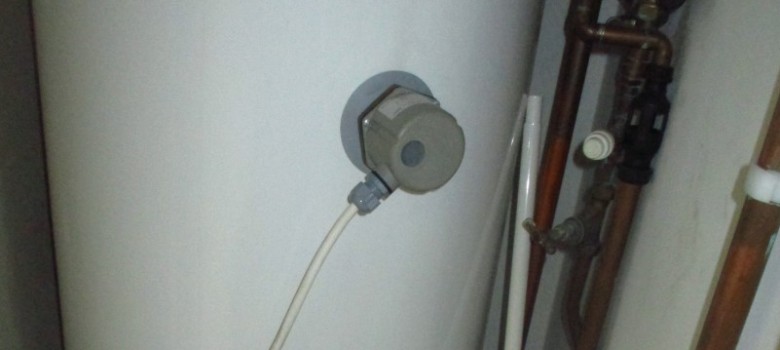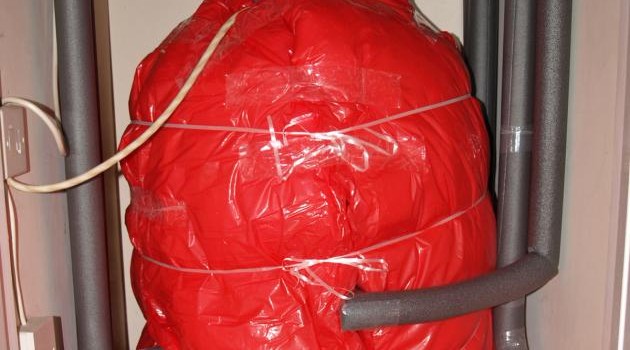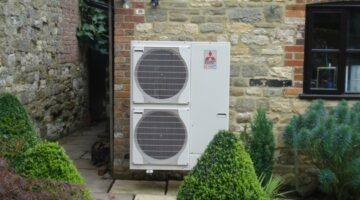
If you have ever looked at your electricity bill you will see that electricity is measured in kiloWatt hours (or kWh). A kWh is a unit of energy equivalent to one kW of power expended for one hour.
An average 3 bed home will use approximately 4,000 kWh of electricity per year; that includes things like lighting, watching TV and running a dishwasher.
In some cases, people heat their water with electricity – normally through the use of electric immersion heaters that act like huge like kettles. We often get asked whether these are expensive to run, so the following should help you work that out for yourselves!
How many KW of electricity are needed to heat a hot water tank?
So the two bits of information you will need to help calculate this are the size of the tank measured in litres, and the required temperature rise.

The following formula can then be used to calculate the power (in kW) needed to heat a specific volume of water by a given temperature in 1 hour.
Volume of tank x 4 x temperature rise / 3412 = Power required
So if the tank is 125 litres and you want to take the water up to 650C from 100C, then it would simply be:
124 x 4 x 55 / 3412 = 8kW
This means that you would need 8kW of electricity to heat this volume of water in 1 hour. If you wanted to heat it in 30 mins you would need 16kW of power, and so forth.
Immersion heaters are measured in kW
When you buy an immersion heater it is given a kW rating, for example 3kW or 6kW.
If you take the example of required temperature rise above and you have a 3kW immersion heater it would take about 2hrs 30 to heat the water (3kW each hour, so in two and a half hours that would give 7.5kW).
Cost of running an immersion heater
The cost of electricity is about 14p/kWh, which means that it would cost about 45p to run a 3kW immersion heater for an hour.
Normally though, the immersion will turn on and off via the thermostat so the amount of time they are on fluctuates, depending on the existing temperature of the water in the hot water tank.
Hopefully the above has been useful and you can apply it to your home! Please remember that hot water should be heated to at least 600C in order to kill legionella bacteria!













We have a house heated only by electric (not storage heaters) and a 150l unvented water tank heated by immersion heaters. If I want to use the showers in the morning and again in evening is it best to heat up the whole tank and hope it stays hot long enough for the afternoon? I’m wondering what the most economical way to use it is. I can be away for a week or two at a time so it is not used constantly but i am confused by all the different answers as to which is the most economical way to use it. Solar is not an option for our house and nor is there outside space for a heat pump. I understand water should be heated to 60degrees to guard against legionella bacteria but how safe is it to use if it’s been standing for a couple of days cooling down and then you just heat it up quickly for a shower say?
What is the 3412 below the line and the 4 above the line???
Hi we had a new heating system fitted and the company who fitted it left the emersion on 24 hours 7days a week for 6 months how can we calculate how much this has cost us so we can claim it back many thanks
Hi Andy, on the face of it this is really simple – i.e. if it is 3kW rated immersion, then each hour this is on it will cost approximately 40p (depending on how much you pay for electricity – but simply multiply your tariff rate by 3). This would give a figure of £1728 over the 6 months – the thing is though that immersion units have a thermostat built in to them. This means when the water in the tank reaches the predetermined level then the immersion unit turns off. Imagine the immersion as a kettle – when the water boil, the kettle element turns off. The same thing happens here, so the actual figure is impossible to calculate so apologies!
By turning it off which i did after i came across your article, you could just monitor your electricity usage and compare, and thats how much you wasted. We simply halfed our electricity cost switching it off. 2 years in the dark tho omg
Hi Andy, how did you arrive at this figure of £1700 ish???????? to achieve this the immersion would need to run flat out for 6 months. If someone is going to make a claim lets try to get a more realistic figure which should be achievable by the meter reading now the immersion is off.
How much does it cost to heat my hot water off my gas system compared with an immersion heater?
Hi Ron, so the cost of gas is approximately 3 pence per unit while a unit of electricity is approximately 12 pence. It depends on the efficiency of your boiler, but new boilers are approximately 90% efficient. Therefore to produce one unit of useful heat you are looking at a cost of 3.3 pence. Electric heating is 100% efficient, so it will cost approximately 12 pence. Therefore if you can heat water using your central heating system then it is considerably cheaper (about 1/4 of the price).
Hi
I’d like a simple yes or no about the electric emmersion heater. I have mine on 24 seven, 7 days a week. Would it be cheaper to turn it off and on as and when it’s needed?
Haha – sadly not a simple question. I would suggest though (to keep things simple) you turn it on and off as needed since heat loss always occurs.
It costs €400 per year for 3kw immersion running constantly in a house with 5 people and filling a dishwasher and washing machine with hot also. My machines are plumbed this way.
hello!!!!…
i would like you explain on me your equation “Volume of tank x 4 x temperature rise / 3412 = Power required”
– number 4 what does it mean?
– Temperature rise/ 3412 what does it come on?
Thank you you kindly before!!
its the specific heat capacity of water. the amount of watts required to raise 1 litre of water by 1 degree centigrade
thank you really helpful a new product has come on the market a panel(placed on wall or roof) based on air heat pump recovery it costs about £5500 and the leaflet says it heats a 200l tank aday to 55centigrade and costs about 115 a year to run. you site has been very helpful working out what the savings would be installers say in practice it is heating 400 litres as they have installed on a dairy farm that empties the tank when 55 into a large 750l tank and its doing it twice day at present.the bit on heat pumps is useful too about 1/3 energy to run. so maximum would be 400 times 4 times 45temp rise /3412 times 365 about 7700kw minus third (running costs) say 2500 (about 450 pounds rather than 114 as plublished) about 5200kw about 936pounds about a 6year pay back best case. if only 200l it would be a 13year payback. tom craig (dairy farmer)
For those asking about the 4 and the 3412 in the equation:
The 4 is the Specific heat capacity of Water (its actually 4.184 Joules)
The 3412 Converts the Calculated BTU’s into KW
I think this formula is incorrrect. The correct formula is energy required in J = mass of water x specific heat capacity of water x temperature rise (in Centigrade). 1 litre of water = 1 kg so volume can be substituted for mass. The specific heat capacity of water is 4200 J/kgC. To convert Joules to KWh divide by 3.6 x 10^6. So the formula should be volume x 4.2 x temperature rise/3600
Yes, Russell’s formula is correct. It’s nothing to do with British thermal units. However, if you use the more accurate value for the specific heat capacity of water 4.184 J/kg/C and divide that by 3600 (the number of seconds in an hour) you get a value approximately equal to 4/3412. So the formula in the article gives the correct answer, but the way it is presented is very odd. (The 3600 is required to convert from kJ to KWhours which is what an electricity unit is)
Dear Greenage and all, I am trying to work out the best heating system for my 1 bed detached bungalow and weighing up between Herschel infra-red and Quantum storage heaters, The house only has electricity, so no gas option. I will be heating my water – a new 210litre unvented electric immersion heater with electric too obviously (I like a bath and thus the large tank!)
My query is whether any argued savings by using infrared heating are lost by having to heat the water on a standard tariff, whereas if I went down the storage heater route I’d get cheaper E7 rate for them both. Any impartial advice gratefully appreciated.
Hi,
I’m looking at buying a house which needs updating and have the option to go with an immersion heater to supply all hot water needs or individual 3kw electric heaters under wash hand basins with 10kw electric shower heater/mixers.
We don’t need baths or any quantity of hot water to kitchen sink.
My gut feeling is that heating an immersion cylinder, maintaining that temperature until required then losing the “dead leg” of water in the pipe is wasteful.
Is there significant saving to be had one way or the other given the on demand electricity would be at a single rate versus economy 7?
Thanks
Geoff
Useful page, and nice explanation of KWh at the start – but the rest of the page uses “KW” whenever it means “KWh”.
Prices here a wildly inaccurate, as this page is eight years out of date